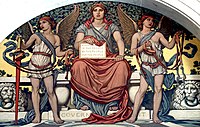
Photo from wikipedia
ABSTRACT This article critically analyzes inflation targeting (IT) both theoretically and empirically. IT came into prominence in the 1990s and 1 central bank after another adopted this regime in the… Click to show full abstract
ABSTRACT This article critically analyzes inflation targeting (IT) both theoretically and empirically. IT came into prominence in the 1990s and 1 central bank after another adopted this regime in the 1990s and 2000s. Proponents of IT mainly argued that IT regime was successful on the grounds that it resulted in lower inflation rates and hence better economic performances. However, inflation rates in the world were in a downward trend from the 1980s well into the 2000s, and both IT and non-IT regimes managed to decrease their inflation rates. In addition, focusing too much on price stability through IT paved the way for permanently higher than necessary interest rates and disinflationary “tight” monetary policy periods when inflation rate was above an arbitrarily targeted level. Tight monetary policy can and do affect the real economy negatively and overemphasizing price stability may hurt the economy in terms of lower potential output, decreasing investment and more unequal income distribution. Post Keynesians offer valuable alternatives within the framework of parking-it approach to the existing monetary policy paradigm. Our main conclusion is that central banks should set the policy interest rate as low as possible and keep it there, in line with Keynesian “cheap money” policy.
Journal Title: Journal of Post Keynesian Economics
Year Published: 2017
Link to full text (if available)
Share on Social Media: Sign Up to like & get
recommendations!